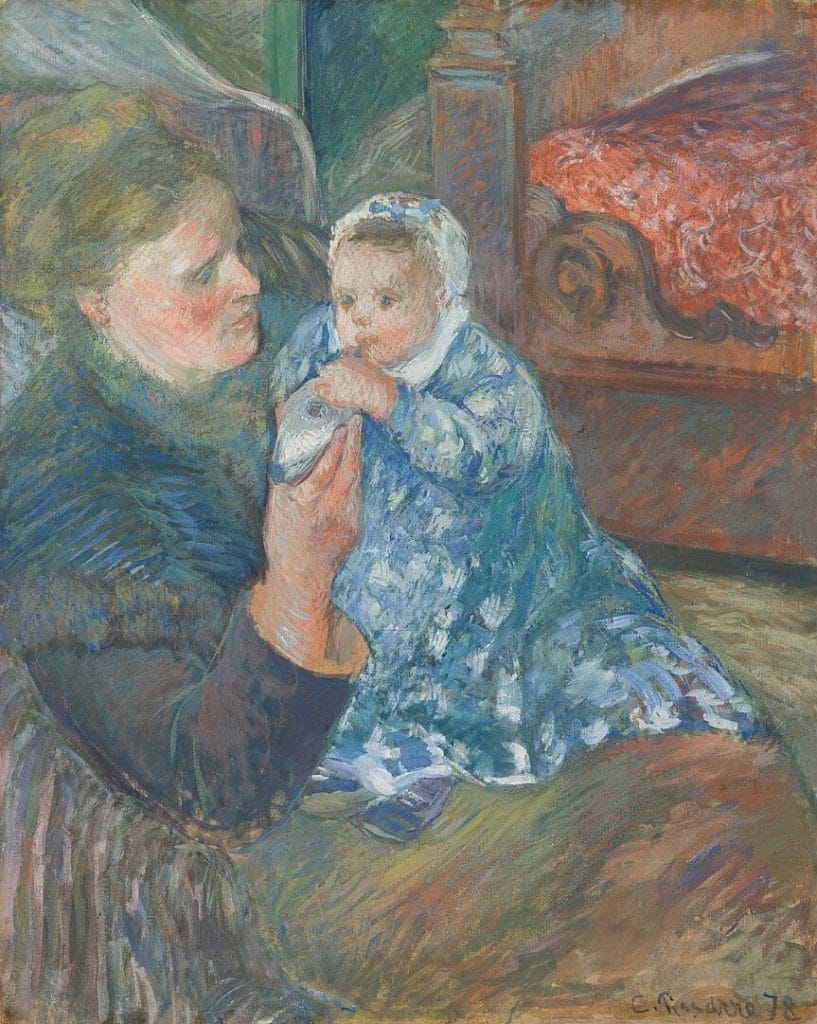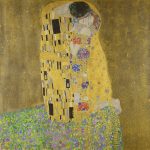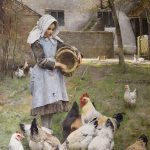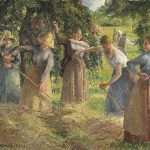
Camille Pissarro, one of the most influential figures in Impressionist and Post-Impressionist art, shared his life with Julie Vellay, a woman whose dedication helped shape his legacy. Their bond was a blend of love, resilience, and shared vision that enabled Pissarro to pursue his artistic ambitions. Often overshadowed by his achievements, Julie’s steadfast support provided the stability and encouragement that Pissarro needed to overcome immense challenges. Together, they forged a partnership that defied societal norms and endured the trials of a rapidly changing 19th-century world.
Julie’s role in Pissarro’s life extended far beyond that of a wife. She was a confidante, a manager, and a steadfast partner who anchored the family during financial and personal struggles. Their story is one of devotion in a time when artists often faced harsh criticism and economic uncertainty. The unwavering support they offered one another allowed their relationship to thrive despite external pressures.
In an era where social conventions dictated strict class and religious boundaries, their union was unconventional. Julie, the daughter of a vineyard worker, and Camille, a Jewish artist of middle-class origins, defied societal expectations to prioritize their love. This remarkable partnership not only strengthened their personal lives but also influenced Pissarro’s art, as he often drew inspiration from their life together.
Understanding the relationship between Pissarro and Vellay provides deeper insight into the man behind the masterpieces. Their shared journey offers a compelling narrative that sheds light on the personal sacrifices and triumphs that accompanied the creation of his enduring works. Julie Vellay was not merely a supporting character in Pissarro’s story; she was a central figure in a life defined by love, family, and artistic passion.
The Early Lives of Camille Pissarro and Julie Vellay
Camille Pissarro was born on July 10, 1830, in Charlotte Amalie, a bustling town on the Caribbean island of St. Thomas. Raised in a family of French Jewish descent, he grew up surrounded by the vibrant colors and textures of colonial life, which later influenced his art. As a child, Pissarro displayed a strong interest in drawing, often sketching his surroundings. His parents, however, expected him to pursue a more traditional career, a common expectation for middle-class families at the time.
At the age of 12, Pissarro left St. Thomas for schooling in France, where his artistic inclinations deepened. Returning to St. Thomas as a young man, he worked in his family’s general store but remained captivated by the idea of painting. A transformative friendship with Danish artist Fritz Melbye led Pissarro to abandon commerce and embrace art fully. Together, they traveled to Venezuela, where Pissarro honed his skills and began to explore themes of everyday life that would later define his work.
Julie Vellay, born in 1838, came from a humble background in rural France. The daughter of a vineyard worker, Julie grew up in a close-knit, hardworking family that valued practicality and perseverance. Her upbringing in the countryside imbued her with a deep connection to rural life, which later became an important influence on Pissarro’s work. Julie’s early years, though largely undocumented, shaped her into a strong, resourceful woman who would play a crucial role in her husband’s career.
The early lives of Camille and Julie highlight their contrasting social and economic circumstances. Despite these differences, their shared values of resilience and dedication set the stage for their enduring partnership. Julie’s rural roots and Camille’s global perspective combined to create a unique bond that would carry them through decades of challenges and triumphs.
A Love That Defied Conventions
Camille Pissarro and Julie Vellay met in 1860s Paris, a city that was both a haven for artists and a bastion of rigid societal norms. Their relationship began at a time when Pissarro was struggling to establish himself in the competitive art world. Julie, with her pragmatic nature and unwavering support, quickly became an indispensable presence in his life. Their connection grew stronger despite the many challenges posed by their differing backgrounds.
Julie’s modest origins as the daughter of a vineyard worker contrasted sharply with Pissarro’s middle-class upbringing and Jewish heritage. In 19th-century France, such differences were often met with skepticism and prejudice. Marrying outside one’s social class and religion was seen as defiance against societal expectations. Nevertheless, Camille and Julie prioritized their love over the judgments of others, forging a life together based on mutual respect and shared goals.
Their relationship also faced economic challenges, as Pissarro’s art was slow to gain commercial success. Julie’s dedication to managing their household and raising their children allowed Pissarro to focus on his work. She became the steady force that enabled him to navigate the uncertainties of an artist’s life. Her belief in his talent never wavered, even when the family faced financial strain.
Through their enduring love, Camille and Julie defied the conventions of their time. Their relationship was a testament to the power of partnership, built on a foundation of shared perseverance and devotion. By refusing to conform to societal norms, they created a life that celebrated individuality, creativity, and the strength of their bond.
Marriage, Family, and Artistic Inspiration
In 1871, amidst the aftermath of the Franco-Prussian War, Camille and Julie formalized their union through marriage. This pivotal moment marked the beginning of a new chapter in their lives, defined by their growing family and shared dreams. Despite the external turmoil of the times, their marriage provided a stable foundation for their children and Pissarro’s career. Over the years, the couple welcomed eight children, creating a vibrant household filled with love and creativity.
Julie’s role as a mother was central to the Pissarro family’s dynamic. She managed the daily responsibilities of their large household, ensuring their children were cared for and educated. Among their children, Lucien Pissarro stood out as a talented artist who followed in his father’s footsteps. The artistic environment nurtured by Camille and Julie influenced not only Lucien but also several of their other children, fostering a legacy of creativity that extended beyond Camille’s own work.
Family life often served as inspiration for Camille Pissarro’s art. His paintings frequently featured scenes of domestic harmony and rural life, reflecting Julie’s influence and the warmth of their home. Julie’s rural upbringing played a key role in shaping these themes, as her connection to the countryside resonated deeply with Pissarro’s artistic vision. The simplicity and authenticity of their family life became recurring motifs in his work.
Their marriage was not just a union of love but also a partnership that enriched Pissarro’s art. Julie’s support allowed him to focus on his creative pursuits, while her presence inspired some of his most memorable works. Together, they built a life that celebrated family, art, and the enduring strength of their relationship.
Julie Vellay: The Silent Partner in an Artistic Legacy
Julie Vellay’s role in Camille Pissarro’s life extended far beyond traditional domestic duties. While Pissarro was celebrated for his revolutionary contributions to art, Julie worked tirelessly behind the scenes to support his career. She managed the household, cared for their children, and often handled the family’s finances during challenging times. Her dedication provided Pissarro with the freedom to focus on his artistic pursuits, even when financial stability seemed out of reach.
Julie’s sacrifices were numerous, and her contributions were instrumental in maintaining the family’s cohesion during periods of hardship. The Pissarros faced frequent financial struggles, especially in the early years when Camille’s art was undervalued. Julie’s practical skills and frugal management kept the household running, allowing Pissarro to concentrate on creating groundbreaking works. This quiet yet essential role underscores her immense impact on his success.
Although Julie rarely appeared in the limelight, her influence can be seen in Pissarro’s art and letters. Correspondence between Pissarro and his friends occasionally mentions Julie, painting a picture of a devoted and resilient woman. Her presence in his life was a stabilizing force, ensuring that the family weathered the difficulties that came with Pissarro’s commitment to his craft. Without her support, many of his most iconic works may never have come to fruition.
Julie’s role as a silent partner highlights the often-overlooked contributions of women in the lives of celebrated artists. She was not merely an observer but an active participant in creating the conditions that allowed Pissarro’s talent to flourish. Her legacy, though understated, remains an integral part of the Pissarro story, showcasing the power of partnership and shared purpose.
Collaborations, Relationships, and Partnerships in Pissarro’s Life
Camille Pissarro was a central figure in the Impressionist and Post-Impressionist movements, collaborating with artists like Claude Monet, Paul Cézanne, and Edgar Degas. These relationships were crucial in shaping his artistic philosophy and pushing the boundaries of traditional art. Julie’s support extended to fostering these professional relationships, often welcoming Pissarro’s peers into their home. Their household became a hub for artistic exchange, reflecting Julie’s role as a quiet enabler of these collaborations.
Pissarro’s relationship with Paul Cézanne was particularly significant, with the two artists sharing ideas and techniques. Julie’s presence ensured that the family’s home was a hospitable environment for Cézanne and other visitors. While Camille and his contemporaries debated and experimented, Julie provided the stability and warmth that kept the family grounded. This dynamic underscored her ability to balance her domestic duties with her husband’s professional life.
The Pissarro home also hosted younger artists like Georges Seurat and Paul Gauguin, who sought Pissarro’s mentorship. Julie’s patience and understanding made it possible for these relationships to flourish, even during difficult times. By maintaining a supportive atmosphere, she contributed indirectly to the growth of these artists and the broader Impressionist movement. Her contributions were subtle yet pivotal in sustaining Pissarro’s position as a leader in the art world.
These collaborations often required sacrifices from Julie, who shouldered the burden of maintaining the household. Despite this, she never wavered in her support of Camille’s artistic ambitions. Her quiet strength enabled him to foster meaningful connections with his peers, ensuring his continued relevance in a rapidly evolving artistic landscape.
Challenges and Triumphs: A Life Together in Art
Camille and Julie Pissarro’s life together was marked by both immense challenges and remarkable triumphs. Financial instability was a recurring issue, as Pissarro’s avant-garde style often struggled to find buyers in his early career. Julie’s resourcefulness and resilience played a vital role in keeping the family afloat during these lean years. Her ability to manage limited resources ensured that Camille could continue creating, even when sales were scarce.
The Franco-Prussian War in 1870 forced the family to flee their home in Louveciennes, leaving behind many of Pissarro’s early works. This loss was a devastating blow to Pissarro, but Julie’s unwavering support helped him persevere. The family eventually resettled, and Pissarro resumed his artistic endeavors with renewed vigor. Julie’s presence during this tumultuous time exemplifies her role as a pillar of strength in their relationship.
As Pissarro’s reputation grew, the family began to experience the rewards of his artistic success. Julie took quiet pride in her husband’s achievements, even as she continued to manage the practicalities of their household. Their later years were marked by a sense of fulfillment, as Camille’s work gained recognition and financial stability improved. Through it all, Julie remained steadfast, ensuring that their family thrived.
Despite health challenges in their later years, Camille and Julie’s bond only deepened. Their shared experiences and mutual dedication allowed them to face life’s difficulties with grace. Their story is a testament to the power of love and partnership, showcasing how resilience and support can lead to both personal and professional triumphs.
Legacy of Love: Julie’s Influence on Camille Pissarro’s Work
Julie Vellay’s influence on Pissarro’s art is evident in the themes of domesticity and rural life that permeate his work. Her connection to the countryside inspired Pissarro’s depictions of rural landscapes, often characterized by a sense of tranquility and harmony. These paintings reflect not only Camille’s artistic vision but also Julie’s grounding presence in his life. Her influence can be seen in works such as The Harvest and The Garden at Pontoise, which celebrate the simplicity of rural existence.
The Pissarro family itself became a recurring subject in Camille’s art. His paintings of their children and family life offer intimate glimpses into their world, capturing moments of love and connection. Julie’s role as a mother and wife is subtly celebrated in these works, which emphasize the warmth and stability she brought to their household. Through these paintings, Pissarro paid quiet tribute to the woman who shaped his life and art.
Julie’s contributions extended beyond inspiration; her support allowed Pissarro to take creative risks that defined his career. By providing stability at home, she gave him the freedom to experiment with new techniques and collaborate with other artists. This creative freedom was essential in establishing Pissarro’s legacy as a pioneer of Impressionism and Post-Impressionism.
The legacy of Camille and Julie Pissarro is one of partnership and shared purpose. While Camille’s name is celebrated in the art world, Julie’s influence is an indelible part of his success. Together, they created a life that celebrated love, family, and the transformative power of art, leaving behind a legacy that continues to inspire.
Key Takeaways
- Camille Pissarro and Julie Vellay shared a partnership rooted in love and resilience.
- Julie’s sacrifices and support were instrumental in Pissarro’s artistic success.
- Their unconventional union defied societal norms of 19th-century France.
- Family life and rural themes influenced Pissarro’s art, reflecting Julie’s grounding presence.
- Their enduring bond remains an inspiring example of love and dedication.
FAQs
1. Who was Julie Vellay?
Julie Vellay was Camille Pissarro’s wife, a devoted partner who supported his artistic ambitions and managed their family life.
2. How many children did the Pissarros have?
The Pissarros had eight children, several of whom pursued artistic careers, most notably Lucien Pissarro.
3. What challenges did Camille and Julie face?
They faced financial instability, societal prejudice, and personal hardships, including the Franco-Prussian War and health challenges.
4. How did Julie influence Camille’s art?
Julie’s rural background and family life inspired themes of domesticity and pastoral tranquility in Pissarro’s work.
5. What is the legacy of Camille and Julie’s partnership?
Their partnership exemplifies love, resilience, and shared purpose, leaving a lasting impact on Pissarro’s art and life.
Meta Description:
Explore the inspiring partnership of Camille Pissarro and Julie Vellay, a love story that defied conventions and shaped the legacy of Impressionist art.




